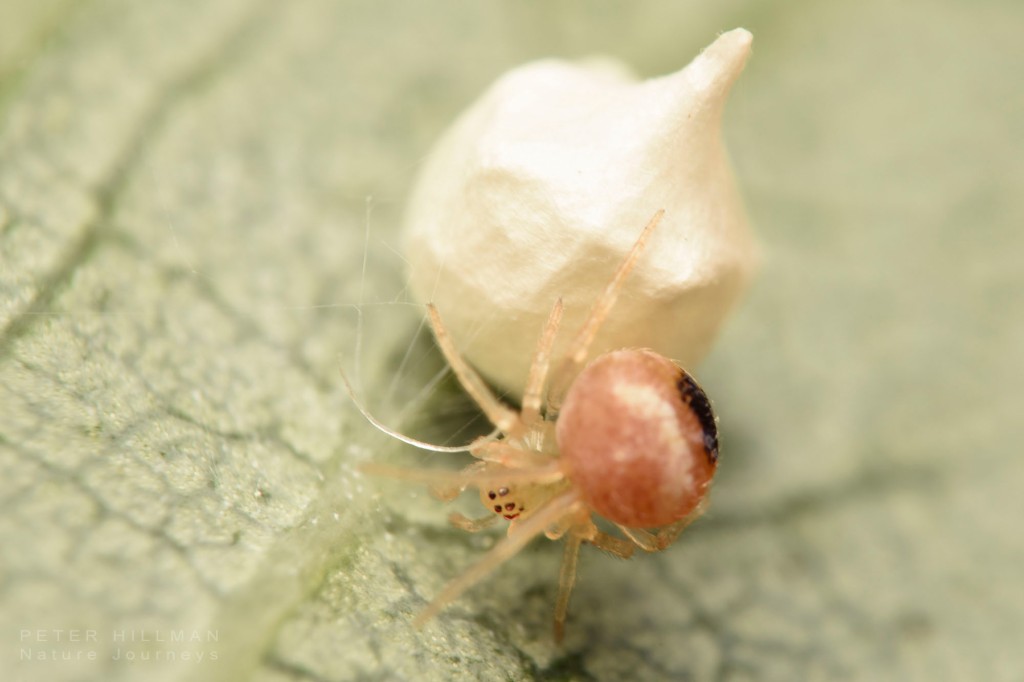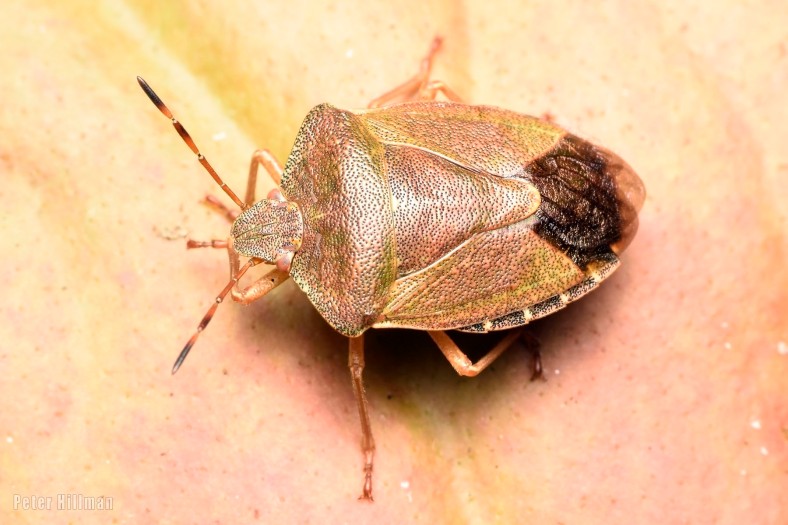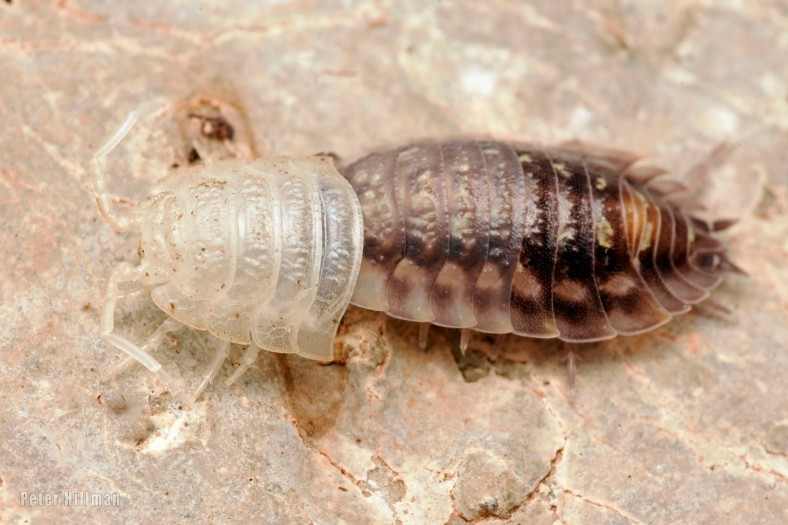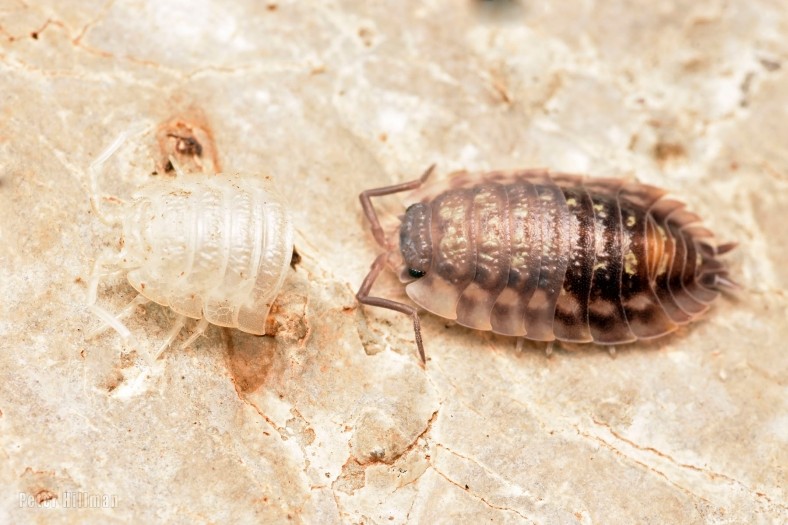Mallards (Anas platyrhynchos) are often taken for granted, but I hadn’t seen one for quite sometime. So when I came across several males and females on the local canal they were a pure delight to see as they paddled across the still waters with autumn reflections.
Tag: Wildlife Photography
Small Wonder
x3 images. Double click to enlarge.
Another dedicated mother looking after her eggs. This is the Cream-backed Comb-footed Spider (Neottiura bimaculata), which was a new species for me this year, discovered in the back garden.
Only a small one with a body length of around 3 mm (1/8 in). The female carries her egg-sac attached to her spinnerets.
Sputnik
The Unknown
I came across this green, wavering cushion which is around 25 mm (1 in) in diameter in my birdbath. The water is crystal clear, but here was this thing quite happily growing there. I don’t know what it is. It might be an alga of some kind, or it could be be something from outer space which hitched a ride on a meteorite. Just hope I don’t get any ‘pod people’ growing in the flowerbeds …
Little One
All Kinds of Nuts Will Do
I want That
Kentish Snail
x3 images. Double click to enlarge.
The Kentish Snail (Monacha (Monacha) cantiana) is one of the commonest snails I notice on my walks along the edge of local woodland.
The shell has a lovely mottled appearance, which can vary. It is one that can be found in gardens, too, but I have not seen any here in my own.
Netted Slug
Pergamasus
x3 images. Double click to enlarge.
I just really like some names of species (or in this case the genus) so I used it as the title for this post.
Pergamasus are verocious predatory mites of soil and leaf-litter. And unfortunately not much more info is forthcoming.
Here are three individuals I discovered .. yep, under that plant pot.
One of The Smallest
x2 images. Double click to enlarge.
This is one of the smallest mites I have come across. I discovered it by simply lifting up a small plant pot. And once disturbed they never stay still for a second, so you have to try and focus and snap them on the move. In fact, I can only see them when they move.

I have manged to get them down to genus which Eupodes. They are one of the trombid mites (Order Trombidiformes), and are so small they are usually measured in µm (micrometres). Even with the Raynox conversion lens I have had to crop these images. They are around 0.2-0.5 mm in length. Quite distinctive mites with pinkish legs and antennae, and pinkish longitudinal dorsal stripes which varies in width. Seen all year round in soil, leaf litter and amongst mosses – or even sheltering under plant pots.
Say “Hi!” To Pudibunda
x5 images. Double click to enlarge.
About a month ago my neighbour calls round (he hit 80 this year and is as fit as a fiddle), and in the palm of his hand he had this little critter. He wondered what it was (he really has an interest in wildlife), and he thought it had fell from a bush he had cut back. I identified it as the larva for the moth the Pale Tussock (Calliteara pudibunda).
Later he came around again with another he had found on his apple tree. They feed on a large variety of deciduous trees and shrubs, and I was quite amazed to discover, like paint, they come in a variety colours, from yellow, green, to orange, pink and red. Don’t think they do any shades of blue though.
Below is the familar adult, which I have featured before, which is also quite an odd yet interesting character. Who would have thought that, that would turn into that, eh?
In case you was wondering, the caterpillars where put back safe and sound to continue their feedathon.
Over 250 Moths Over 16 Years
x16 photos. Double click to enlarge
It was when I purchased my first digital camera back in 2005, a Sony Cybershot compact camera, that my love for nature and the side of the natural world, that is not always often seen but is always there to be found, became rekindled. My interest in moths – ‘moth mania’ I call it – began from a young age when I used to stay up a little at night with my older brother Steve, looking out for these nocturnal insects. In those days I used to paint and draw them, especially those with vivid patterns and colours like the Garden Tiger, which has sadly declined over the years since, and I have not yet seen one here to photograph.

So since 2005, I have photographed over 250 (and still counting with lots of past images still to go through and positively identify) species of moth and have uploaded them to this site. 250 is small fraction of the 2,500 or more species of moth to be found throughout Britain. Not all are attracted to light. Some are attracted to feromones or sugar. Some are day-fying moths, and some are rare and localised to different areas of the country.
Oddly enough, in the year 2010 I apparently did not take one single moth photo, but a year later moth mania hit me again and I photographed over 150 different species of moth!

After buying different compact cameras over the years, it was in 2014 I purchased my first DSLR camera the Nikon D3200.
2016 was the year I upgraded my camera to the Nikon D7200 (which I still use to this day) , and in 2017 it was another year the moth mania got to me. It was a very bountiful year for moths.
The thing with moths is that they can be seen all year round, even during the winter months where most other insects are hibernating.
Spotlight on The Grey Dagger Acronicta psi
There are two very similar ‘dagger’ species in Britain, the Grey Dagger (Acronicta psi) and the Dark Dagger (Acronicta tridens). The adults cannot be accurately identified visually without genital dissection and microscopic scrutiny – but I don’t like to harm them so this adult would be recorded as an aggregate species Acronicta psi/tridens. The adult is readily attracted to light, and is seen in June and August in most habitats, including woodland, hedgerows and gardens. Sadly its numbers have significantly decreased in recent decades.
The caterpillar is quite an odd thing, and on first discovery I thought it had been parasitised! But the long and prounced ‘hump’ or fleshy projection is one of its defining characteristics and which visually separtes it from the Dark Dagger (Acronicta tridens) which has a shorter ‘hump’. A visually striking moth larva with long hairs and a yellow or white dorsal strip. The orange side patches offer quite a contrast in colouration. It feeds on a large range of broad-leaved trees and shrubs, and overwinters as a pupa amongst bark, in rotten wood or in the ground.
The Dangers of Courtship For The Male Garden Spider Araneus diadematus
x7 images. Double click to enlarge.
It’s amazing what you see sometimes as you travel through your own backyard. I spied this female Araneus diadematus some days ago. She is really quite a big individual and had made a large orbweb stretched between a plant pot and some shrubbery. Here she has a good meal ready to go in the shape of a Hawthorn Shieldbug .. in fact, to my crazy mind, she looks like a band member ready to knock out a tune on it.
The next day, on the late afternoon, I spotted the handsome male Araneus diadematus apparenty repairing and tidying her web for her at a distance. But he had also spun a strong silken quick release safety line … more on that later.
In the above image we can see how large the female is compared to the male. She looks rather intimidating … and she is. I watched as the male Araneus diadematus tentatively approached her along the web, getting a little closer, the female closing the gap … and the male backing off from time to time keeping a little distance between them. He was testing the waters, and so he should. Female Araneus diadematus practices sexual cannibalism before and after insemination. One thing in his favour is the large food package she already has nicely wrapped up … but he certainly didn’t want to be seconds.
Eventually they closed the gap but he was still very sheepish and kept darting back … and on a couple of occasions when he must have read the situation as potentially dangerous rather than amorous he used his pre-made quick release safety line to swing back a good distance out of harms way. They must have been playing this cat and mouse courtship game for a couple of hours … and I don’t know what the outcome was in the end for the male. The next day had seen overnight rain which had damaged some of the web, but the female was found sheltering under a leaf. The male was nowhere to be seen. He was either inside her as last nights late supper … or he had gone off in search of another mate with an extra swagger to his gait.
Sexual cannibalism in spiders is a long-standing evolutionary paradox because it persists despite extreme costs for the victim, usually the male. Several adaptive and nonadaptive hypotheses have been proposed to explain this phenomenon, but empirical studies are still scarce and results are inconclusive.
Getting Even Closer

This is Dicyrtomina saundersi, a springtail, and boy do they jump if they feel threatened. This is an uncropped image. I have experimented with extension tubes for the first time ever this morning, and have found using the 36 mm tube in combination with my Raynox 250 they work pretty well. Normally I would have had to crop the image some to get closer.
The original image was 6000 x 4000 pixels but I have reduced it down to 2000 x 1333 pixels for internet use and have reduced the quality a little to bring down the file size.
Oh, and yes, I probably snapped this individual at an inopportune moment … but there you go in the world of photography.
Katiannidae genus nov.1. sp. nov.2

You may be wondering what an earth this blog title means? Well, coincidently for me, this is another of those species which has yet to be given a proper name!

This is a globular springtail of around 1.5-2 mm (around 5/64 in). It has to be the prettiest and perhaps the cutest I have seen, and has now become my favourite.
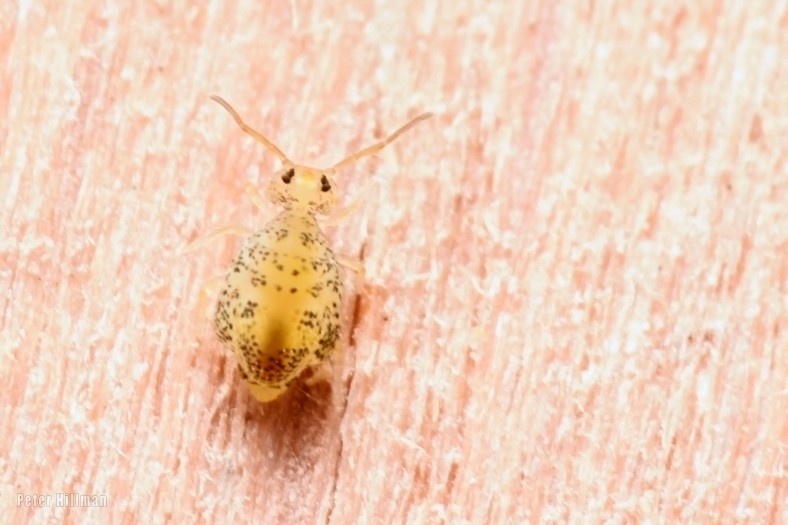
It is believed to have been imported from Australasia and associated with the horticultural trade. That is all the information I have been able to gain so far regarding its origin. There is no knowing its status here in the UK, either.

It appears to be fairly variable, and is seen in gardens and parks, and probably allotments and garden centres. I believe the bottom image may be a juvenile as it was smaller than the individuals above.

In Autumn Colours
Time For A Change
Pill Millipede Glomeris marginata

This species of millipede looks rather similar to a woodlouse, and this can often lead to some confusion in identification. Its common name refers to its habit of rolling into a tight ball to protect itself from predation and to prevent itself from drying out. It is greyish-brown to blackish in colour, with about 11 tight-fitting calcareous plates running down its body. It has numerous legs.

It feeds on various rotting plant material, and helps to recycle soil nutrients.

A common and widespread species throughout Britain, except the far north where it is absent

Phalangium opilio

This is another new species for the garden, and they all appear to like my shed wall for some reason. This is a lovely female.

A long-legged harvestman with an indistinct and variable light gray or brown body pattern. The saddle has one or two restrictions along its length giving it a waisted, or double-waisted appearance. Males have a large spur or horn projecting from the anterior surface of the first cheliceral segment. They also tend to have long, thin pedipalps relative to those of other harvestmen and usually are blacker in colouration than the females.

Found in well vegetated areas such as gardens, brownfield sites, grassland and open woodland. Seen on walls and vegetation.

White-legged Snake Millipede Tachypodoiulus niger

Quite a large dark millipede with a length of up to 60 mm (about 2/34 in). They take 2 to 3 years to mature, and can live for several years after first mating.

It can be seen all year round, and is found in gardens, woodlands and anywhere with rocks or rotting trees under which it can hide. Very common and widespread throughout Britain.
Cuter Than Cute – For A Bug

Dicyrtomina saundersi is its name, and not an insect (although previously considered to be) but a springtail. There is a kind of ‘spaceman’ like figure in the pattern towards the head, and a distinct dark barred patch towards the rear of the abdomen which helps separate it from similar species.

It looked directly up at me here … and appears to have kinda smiled, or may be it was a grimace?

This is a young one, a juvenile, and a female with the pale cheeks. It is around 2 mm (5/64 in) long.

Seen all year round under stones and bark in various habitats. A native species, and fairly common and widespread throughout Britain.

You can double-click images to enlarge once passed the advertising landing page.
An October Chill Session
Common Striped Woodlouse

Philoscia muscorum has a dark stripe along the centre of its back. One of the ‘famous 5’ very common British species of woodlouse most likely to be seen.

Seen all year round, it forages for dead organic matter on which it feeds during the cover of night, hiding under stones, bark or logs during the day.

Woodlice can be quite a challenge to photo, not just because of their small size, but because they generally run off and hide again when disturbed. The camera flash can be problematic, too, for it tends to bounce off the shiny surface of the exoskeleton expressing ugly highlights. A diffuser helps, but control of the light can still be a challenge. To add, narrowing the aperture to around f/36 to get as much detail as possible means flash is essential. You are also outside of the ‘sweet spot’ for sharpness, but all depends on your lens and camera, too. And without a tripod, a steady hand is needed, so bracing on ‘anything’ using ‘everything’ is key.

Equipment: Nikon D7200 with Sigma 105 mm macro lens and Raynox 250 convertor lens. Nikon Speedlight with plastic direct fitting diffuser and fabric diffuser on lens. Hand held. Settings: f/36. 1/160 sec. ISO-320. A little post-processing applied.
One For Halloween
Autumn Is A Time For Harvestmen
Odiellus spinosus – Its been a good year for harvestmen, and I have seen quite a few different species around, but I haven’t seen this one in the garden for some years now. This one has 3 distinct horns of similar length which, together, is called a ‘trident’, and has a dark oulined ‘saddle’ on its abdomen which ends short, combined these are diagnostic features. Notably it has short to medium legs compared to other species of harvestmen. A fierce hunter which prays on other invertebrates, and is found around human habitation like outbuidlings, gardens and houses.



Variegated Centipede
Lithobius (Lithobius) variegatus – This is a fairly large centipede growing up to 30 mm (1 1/4 in) long. It hides during the day under bark, stones, rotting logs or decaying vegetation, emerging at night to hunt other invertebrates by injecting them with venom. Found mainly in rural areas in woodland and moorland.


Hitching A Ride
999 Species
I have now recorded 999 species on this website, from plants to animals, fungi and even a cyanobacterium. I have stopped short of making this post ‘1000’ as the 999th species convinced me to use it as a marker milestone. Not surprising it happens to be an invertebrate, an arthropod, and an insect at that.
Attactagenus plumbeus is a member of the Curculionidae family which make up the weevils. What is so special about this species apart from its own uniqueness is is scarcity. Data gleamed from the NBN Atlas shows only 96 records between 1990 and 2020, and 151 records in total from 1890. The British nature conservation status is Nationally Notable B (species found in between 31 and 100 hectads – 10 km x 10 km square), making it nationally scarce. There are only 4 records for 2020, and 1 of these is mine. Native to Britain, not surprisingly it is very localised with a few scattered records across England and Wales, except the south-east of England, and is absent from Scotland and Ireland. It feeds on plants from the Fabaceae family, including species of vetch and broom, and is found in fields and meadows where the host plants can be found.


The Cheeky One
Something Alien
Daddy Long-legs Spider Pholcus phalangioides
I always have these in the sheds, and garage, and they will also appear in the house. I leave them be in the sheds beacause they are not hurting anyone there or causing any bother, but in the house they have to go outside. If you do see one of these and get too close to it whilst it is dangling upside down in its web it will vibrate quite madly, a way of confusing and putting off predators. It is non-native to Britain, most likely arriving here in imported goods, but it has now become well-established over the past 30 odd years.

Becoming
Snake Drama
Grass Snake (Natrix helvetica) – Strolling along the canal, the light ever changing as slate grey clouds block the sun, threatening rain again, and seeing me with my camera, a friendly fisherman calls out, “There’s a frog being eaten by a snake over there!” I pass under a nearby canal bridge built during the Industrial Revolution and I see a stirring in the canal water on the opposie bank. And low and behold there is a snake gripping a frog around the throat. I would never have thought that my first encounter with a Grass Snake would be so dramatic. They also hunt and eat fish.

Please double-click images for a closer look.
Amazing Builders
Moorhen (Gallinula chloropus) – On a stroll along the local canal I spotted the nest first and the bird second on the opposite side of the bank. I was taken by the construction of woven stems which form this nest, and how it was built on a section of submerged tree. There are jokes about ‘birdbrain’ references, but this one not only had to think of how to construct the nest, what suitable size it should be, and what to line it with, it also had to think of the best place to build it safe from predators and from being washed away by rising water in potential torrential rainfall.
The female lays 5-11 eggs in 2 or 3 broods from April to August.

A Bold Young Blackbird
Blackbird (Turdus merula) – This beautiful young blackbird visited my pond this afternoon as I was watering the garden, and was so bold it stayed a while and allowed me to get quite close. Good job, too, because I only had my macro lens fitted. The last day of May and the last photos of May with a lovely bold young Blackbird to make you smile.

© Peter Hillman ♦ 31st May 2020 ♦ Rear garden, South Staffordshire ♦ Nikon D7200
874 And Counting
It is coming up to 4 years this June that I have been blogging on WordPress. I have done a species tally of the ‘life’ featured on this site, and it is around 874 species, featuring all forms of flora and fauna I have been most fortunate enough to encounter on my life’s journey so far. Below is a selection of photos of just some of these amazing and diverse wonders of nature I have been witness to over the years.
I would like to thank all my dear bloggers here for their continued support, and for their interesting and wonderful contrubutions in their own blogs from all corners of the globe. There are a a lot of wonderfully talented folk here with great passion for their art, whether it is painting, poetry or photography, or any other interest they may have and are sharing on this platform. So a big thanks to all for sharing!
During these very trying times of the coronaviris pandemic it has been more important than ever that people have been able to connect throughout the world, offering their own support in some way to one another, but with social distancing in mind. It has also highlighted how important our green spaces are to us, how dear they are to us, and how nature is good for our troubled hearts and minds, and how being close to it can help in healing. No matter where we are, we are never far from nature, and reconnecting with it is so very easy, and hopefully it is not only hearts and minds that are healed in this process, but the planet as a whole with all its wonders of life.












Hunting & Hunted
Common Frog (Rana temporaria) – Life in the garden pond can be quite a challenge. As featured in a previous post, I watched damselflies hunting flies, snatching them out of the air. Now, as newly emerging damselfies are leaving the water where they have been as larvae for the past year or so, I have seen the frogs leaping out the water in a bid to hunt them for food. There are around 3 or 4 frogs in the pond, as well as all the tadpoles. As if the frogs were not enough, I was but a couple of feet away from a little bird, a Dunnock, as it snatched a freshly emerged damselfy off its perch within the pond. Yet there were dameslflies mating on the margins, coupling to ensure another future generation. Triumph and tragedy in its own little ecosystem.




© Peter Hillman ♦ 7th May 2020 ♦ Rear garden, South Staffordshire ♦ Nikon D7200
Hanging In The Shed
Daddy Long-legs Spider (Pholcus phalangioides) – These have been regular tenants in my sheds and garage (they are evicted from the house on sight) for as long as I remember. I think they are one of the strangest of spiders around. If you disturb them in their web they go crazy and shake and wobble all over the place. Double-click image if you really wanna get closer.
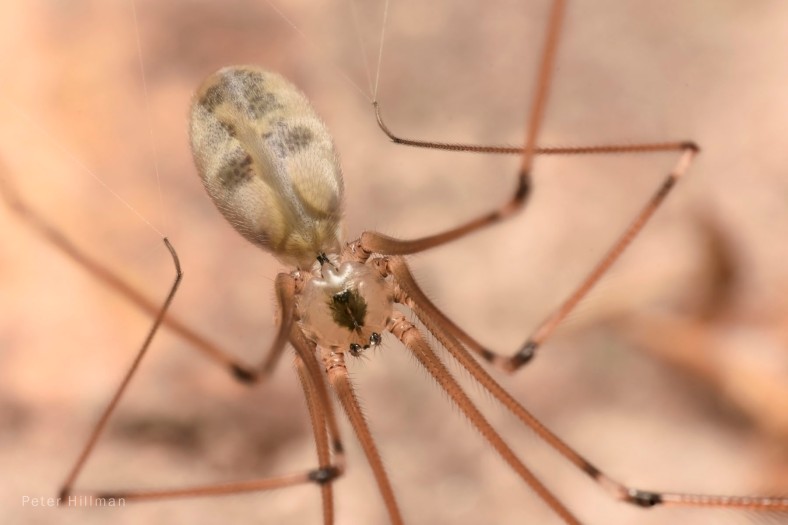
© Peter Hillman ♦ 3rd May 2020 ♦ Garden shed, South Staffordshire ♦ Nikon D7200
You may find my ‘Page of Life‘ of interest, which allows easy access to all species of flora and fauna featured on this site, and might be considered a useful reference.
Growing Bigger
Common Frog (Rana temporaria) – I can’t believe what a frenzy of activity is going on in the garden pond at the moment. It is teeming with tadpoles and all of them are scraping algae from the rocks, so much so some of them are virtually picked clean. They have grown so much bigger, too. Double-click images to enlarge.


© Peter Hillman ♦ 24th April 2020 ♦ Rear garden, South Staffordshire ♦ Nikon D7200







